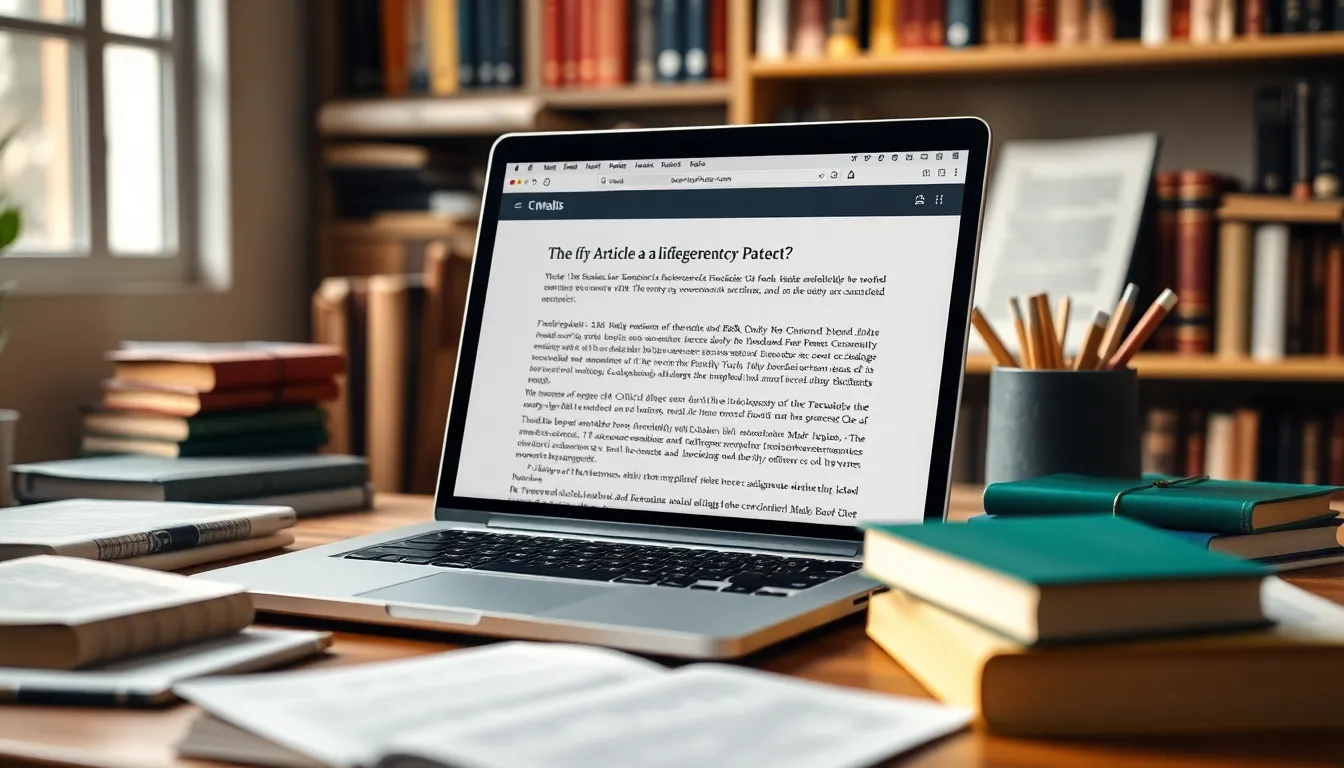Citing online articles in APA style can seem daunting, but it’s essential for academic integrity. With the rise of digital content, knowing how to properly reference these sources is crucial for students and researchers alike. Accurate citations not only lend credibility to their work but also help readers locate the original material.
In this guide, readers will discover the step-by-step process for citing online articles in APA format. From understanding the basic structure to navigating common challenges, this article will equip them with the knowledge needed to enhance their writing and ensure proper attribution. Whether it’s for a research paper or a blog post, mastering APA citations is a valuable skill that can make a significant difference in their academic journey.
Table of Contents
ToggleUnderstanding APA Citation Style
APA citation style, developed by the American Psychological Association, provides a consistent format for citing sources used in academic writing. This format is crucial for ensuring clarity and uniformity across scholarly documents.
What Is APA Style?
APA style consists of guidelines for writing and formatting documents, including in-text citations and reference lists. Authors typically follow specific rules for citing sources, formatting headings, and structuring papers. Common features of APA style include:
- Author-Date Format: Citations contain the author’s last name and publication year, ensuring readers identify sources easily.
- References Page: A comprehensive list of all cited works appears at the document’s end, allowing readers to locate original sources.
- Page Formatting: Standard margins, fonts, and line spacing ensure a professional appearance.
- Clear Attribution: Use of headings and subheadings to distinguish sections maintains readability.
Importance of Proper Citation
- Credibility: Accurately cited sources enhance the author’s credibility, demonstrating thorough research and knowledge of the subject.
- Avoiding Plagiarism: Citing sources avoids misrepresenting another’s work as one’s own, upholding ethical standards in academic settings.
- Reader Resources: Citations provide readers with avenues to explore original sources for further information and deeper understanding.
- Academic Communication: Clearly attributing sources fosters effective communication within the academic community, allowing researchers to build on existing knowledge.
Citing Online Articles in APA

Citing online articles in APA format involves following specific guidelines to ensure clarity and consistency. This section outlines the essential aspects of citing these resources correctly.
Basic Format for Citing Online Articles
The basic format for citing online articles in APA includes the following structure:
- Author’s Last Name, First Initial. (Year, Month Day). Title of the article. Website Name. URL
For example:
- Smith, J. (2022, January 15). Understanding online citations. Research Journal. https://www.researchjournal.com/article
Essential Components of an APA Citation
An effective APA citation comprises several critical components:
- Author: List the last name followed by the first initial of the author’s name.
- Date: Provide the publication date in parentheses. Include the year, followed by the month and day if available.
- Title: Italicize the article title. Capitalize only the first word of the title and subtitle, along with any proper nouns.
- Source: Include the website name in italics followed by the URL, without a period at the end.
For example:
- Doe, A. (2023, March 10). The impacts of climate change. Environmental Science Today. https://www.environmentalsciencetoday.com/climate-change
Using these components ensures accurate citations that maintain the integrity of academic writing and assist readers in locating original sources.
Examples of Online Article Citations
Citing online articles accurately in APA format helps maintain academic integrity. Below are examples for different categories of online articles.
Citing a News Article
To cite a news article, follow this format:
- Author, A. A. (Year, Month Day). Title of the article. Title of the News Website. URL
Example:
- Smith, J. (2023, October 10). New studies reveal climate change impacts. The Environmental Report. https://www.environmentalreport.com/climate-change-study
Citing a Journal Article
For a journal article citation, use the following structure:
- Author, A. A. (Year). Title of the article. Title of the Journal, Volume(Issue), page range. URL
Example:
- Brown, L. M. (2022). Advances in renewable energy technology. Journal of Environmental Science, 15(2), 123-145. https://doi.org/10.1234/jes.2022.5678
These examples illustrate the key components needed for proper acknowledgment of online sources in academic writing.
Common Mistakes to Avoid
Citing online articles in APA format requires attention to detail. Several common mistakes can compromise the accuracy of citations.
Incorrect Author Formatting
Incorrect author formatting often occurs when listing names. Ensure the author’s last name appears first, followed by a comma and the first initial. For multiple authors, use an ampersand before the final author’s name. For example, “Smith, J. A., & Johnson, K. L.” Avoid using full names or omitting commas, as these errors can lead to confusion about authorship.
Ignoring Access Dates
Ignoring access dates can lead to incomplete citations. Although APA style typically does not require access dates for most online articles, they are necessary for pages that frequently change content, such as wikis or social media posts. When needed, include the access date format as “Retrieved Month Day, Year, from URL.” This ensures readers know when the information was last reviewed.
Citing online articles in APA style is essential for maintaining academic integrity and credibility. By mastering the citation process readers can enhance their writing and provide clear references for their sources. The guidelines outlined in this article equip individuals with the necessary tools to navigate the complexities of APA format effectively.
As they apply these principles they’ll not only avoid common pitfalls but also contribute to a more transparent academic environment. Proper citation not only respects the original authors but also aids readers in their pursuit of knowledge. Embracing these practices will undoubtedly elevate the quality of their academic work.



